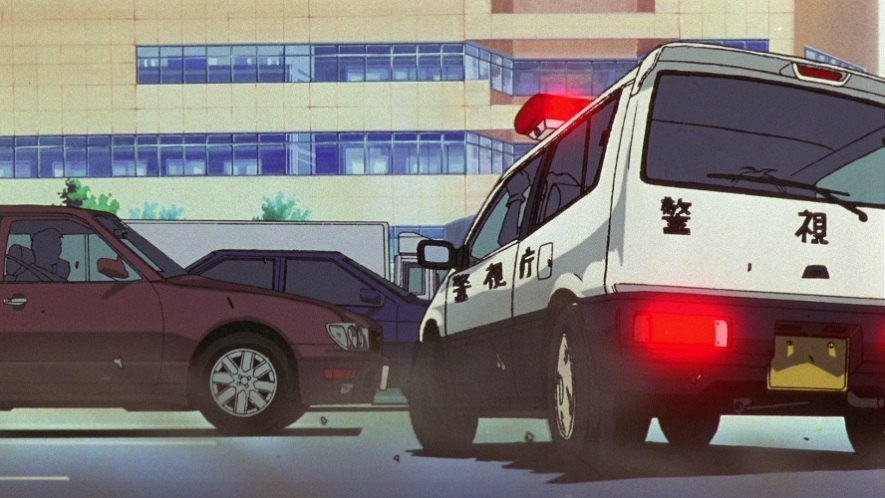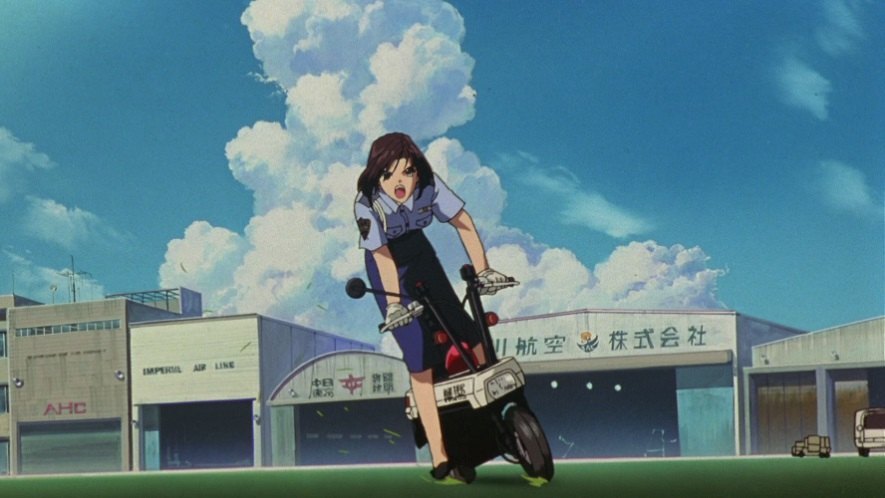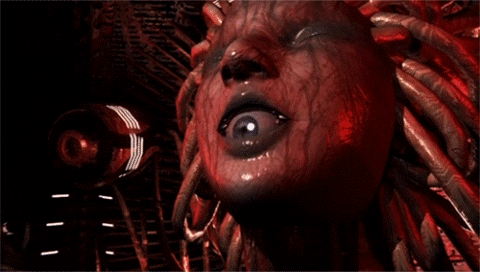 |
| From http://cdn.myanimelist.net/images/anime/1/2134.jpg |
Director: Junji Nishimura
Screenplay: Masashi Sogo and Seiji
Soga
Based on the original manga by Kōsuke Fujishima
Voice Cast: Akiko Hiramatsu (as
Miyuki Kobayakawa); Sakiko Tamagawa (as Natsumi Tsujimoto); Bin Shimada (as Ken
Nakajima); Etsuko Kozakura (as Yoriko Nikaido); Ikuya Sawaki (as Inspector
Tokuno); Issei Masamune (as Chief)
Viewed in Japanese with English Subtitles
The You're Under Arrest! franchise encapsulates how a Japanese
franchise is just as much, if not more, dictated by its success with its home
audiences as it does Western fans. Its known in the West but it was through how
well it did in its home country that, after the original 1986 to 1992 manga,
there have been since 2008 four television series, one live action TV drama,
straight-to-video stories and this feature films based on the antics of the
Tokyo Metropolitan Police Department at the fictional Bokuto Police Precinct station.
Since the manga its followed two female traffic cops. Natsumi Tsujimoto, a
brash and hard-headed woman who appears at work many times with a hangover and,
turning the franchise into a fantastical one, has superhuman strength with her
trademark being able, without causing any permanent harm to herself barring
possible shoe leather costs, to open the door of a moving vehicle she is in
and, through placing her feet on the tarmac below, being able to steer/stop
said vehicle as a result. Her partner Miyuki Kobayakawa is more coolheaded and
collected, though her various interests including cars, computers, booby traps
and firearms, both real ones and fake ones to which the later plays a major
plot point for this feature film. Alongside their motley crew of colleagues and
superiors, they have to tackle anything from speeding to the subject of this
film, a terrorist group who start by causing traffic light malfunctions to
threatening to blow up bridges, intending to actually invade the police station
when knowledge is brought up of a police training scenario on disc so good that
it could actually be repurposed to commit international crime.
 |
| From http://www.animeclick.it/prove/serie/YouareUnderArrest theMovie/YouareUnderArresttheMovie4.jpg |
I've seen three different pieces
of the franchise including this film and I find plenty of potential in You're Under Arrest! as an entertaining
franchise, something as innocuous as traffic cops a potentially fun idea. The light
comedic action tone allowed, over the three entries I saw, for the stories to
juggle between the film's more serious moments, as if its abruptly going to
turn into Mamoru Oshii's Patlabor 2 (1993) in political subtext,
to a sex comedy. The issue with the franchise however is that, while thankfully
this feature film was good, the first two I saw were terrible, the length of
the franchise and its presumed popularity bringing in a danger that, as long as
the characters act like they are expected to, any level of quality can be
accepted. This is a pulp franchise, where the characters over the three pieces
I saw don't change psychologically and the plots are easy to predict in their
outcomes, but this isn't an issue when that can still being imaginative and
fun. The real problem is when lack of good work or storytelling is involved due
to complacency. My first viewing was a series of 1999 TV mini-specials, little
episodes put together on DVD which prioritised the humour more, most of it
bland and suffering from the early transition from hand drawn to digitally
assisted animation with atrocious 3D modelling and digitally assisted camera
pans within scenes. The second was You're
Under Arrest: No Mercy! (2002), where in a bizarre decision to spice up the
franchise the lead heroines were inexplicably transferred to the LAPD in the
US; it is exactly like the parody of spin-offs in The Simpsons episode The
Simpsons Spin-Off Showcase (1997), the one within it specifically about
Principal Skinner and Chief Wiggum inexplicably being detectives in New
Orleans, only with Miyuki drooling over American muscle cars, the characters in
skimpy bikinis on the beach, and being just as silly for only thirty minutes.
 |
| From http://www.imcdb.org/i035528.jpg |
I came into this with trepidation,
especially as the director of this made the mini-specials, the light and frothy
nature of the franchise only over three parts already a double edged sword for
me as a newcomer, where alongside being thrown into stories with the characters
already established the quality could vary greatly. Thankfully, not only can
you build up personalities for the characters for yourself from their quirks,
but this motion feature is a bar higher in terms of quality in every way. The
film's lightweight but it's still a huge leap above many anime outside the
franchise for just getting a lot right. It helps, as a theatrical feature, that
for a simple eighty plus minute film the animation is a high standard, making
director Junji Nishimura's
involvement with the mini-specials baffling but not taking away how pre-digital
drawn animation had a beautiful look to it especially at this good quality. The other factor of why the film
works is a personal one but one that is universal for any reader who becomes
fond of an anime franchise despite the chance of entries being bad, that the
characters especially the two leads of You're
Under Arrest! are memorable, despite being archetypes, to the point you
want to see them in more (preferably good) stories. This encapsulates a virtue
of anime and manga that has been emphasised by manga writer Kazuo Koike - the writer of the original
sources of Lone Wolf and Cub, Crying Freeman, Lady Snowblood and someone whose do well with this advice looking
from those creations - that characters are the most important part of a story. Even
less than great anime such as (blog entry #6) High School DxD (2012) have shown that no matter how lacking and
dubious the stories are the characters can still be memorable, even if it's
just through their designs and their charisma, to the point of wanting them to
be used in better material. Even though they are simple clichés, from the
police superior who is serious sometimes but would start crying if shot in the
knee to the cute nerdy girl in glasses, these characters are likeable in the
film, the two leads in particular managing by their own quirks to make them
memorable anime protagonists that can carry a story along.
 |
| From http://pics.imcdb.org/10555/810.jpg |
The seriousness of this entry in
complete contrast to the other two I've seen was a surprise, but it thankfully
isn't deathly serious which could've been mortally fatal as this isn't Patlabor II with a real depth but
merely a story meant to offer thrills. Comedic characters in other parts have
more seriousness here, and adds a lot to the entertainment, but the humour
prevents this from becoming a slog if it failed to be a deep political drama. In
fact there's a charm from how naive and light the franchise is especially when
trying this serious story, where even if a bridge is blow up and the police station
is threatened no one is actually killed, and the police never go as far as
maiming any criminal to stop them. For one scene, the planned celebration
decoration for a character for when they returned in the country proves to be a
great improvised trap against an armoured grunt or two with full automatic
rifle, surprisingly effective in lieu of what happens. The fact the franchise
bends physics with vehicles and the strength Natsumi has means that the action
scenes in these films have a movie realism that's impossible to dismiss, both
the kind of spectacle of an American action film, if more sedate in tone, but
also capable of ridiculous moments that can get away with what happen. There's as
much a humour in witnessing a character get a perfect shot in hitting a boat
from another boat with a tire as admiring how the moment itself is depicted
from behind the flying tire's point of view as if flies over the body of water
underneath it.
 |
| From http://image.tmdb.org/t/p/original/jsmRA0E0iKdi24sk0edB3m4h0EF.jpg |
The breeziness which could be argued to make
this a minor anime actually is its advantage as well, preventing the film from
slogging at all in its feature length. Unlike the other two You're Under Arrest! anime I saw, this
is paced well and never tedious, never weighed down with any shonky comedy or
plot. That the others were short pieces is really damning of them as they
didn't hold the consistency this much longer work has, and it's as much the
drama being there, where a side character may have knowledge of the person
causing the crime, that helps support the film by giving it a dramatic weight
alongside the humour and thrills. This also makes this a great starting off
point for the franchise, if you can find it, as you can quickly get the
personalities of the characters because of their pulp story nature and have a
well made story, in terms of animation and plotting, to begin with to introduce
them. This is the template for one would hope for from You're Under Arrest!, especially for myself, even in terms of a
television series within the franchise.
 |
| From http://www.imcdb.org/i035537.jpg |








